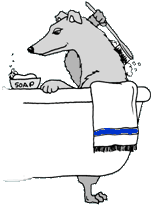 One of the nicest features of your greyhound is that he doesn’t have a lot of hair and this makes him easy to care for. A quick brushing with a grooming mitt (nubbed rubber glove), and lots of petting keeps him looking great.
One of the nicest features of your greyhound is that he doesn’t have a lot of hair and this makes him easy to care for. A quick brushing with a grooming mitt (nubbed rubber glove), and lots of petting keeps him looking great.
Baths
Your greyhound only needs to be bathed when soiled, like if he decides to doze on poop. Otherwise, he’s fine with his routine petting and brushing. Greyhounds have very little oil in their skin and so have little “doggy odor.” If you do need to shampoo, select an all-natural, mild, conditioning shampoo.
My greyhounds were not into baths, even though they got them only about twice a year when the seasons were changing, and they were shedding their coats. I’d have to pick them up to put them in the tub, and as I bathed them their legs would turn to rubber and they’d sink to the tub floor looking very helpless and put out. Just keep bracing them up on their feet. Their shower should take no longer than five minutes and they do survive. Even if they keep telling you they won’t.
Ears
Once a week you should inspect your pet’s ears and clean gently with a cotton ball and baby oil if needed. Don’t use peroxide, as it can cause damage to your dog’s ear drums.
Skin
Their past living conditions (fleas, ticks, poor food, etc.) were not conducive to good skin. Most greys I get from the track have some kind of skin condition. You’ll need to provide a good supplement to their food (Salmon Oil, other Omega 3 fatty acids, Vitamin E, etc.) and give their hair and skin time to grow in nicely. Trust me, it will!
Teeth
Greyhounds have notoriously bad teeth when they come off the track as they’ve been fed a lot of soft food. They’ve been cleaned before you adopted your greyhound, but those teeth get plaque build-up just like yours. Brushing them regularly helps them to stay clean and healthy.
Another way to keep teeth clean is to buy raw turkey necks. Give one a week or every other week, and you’ll never need the dentist. Kknuckle/soup marrow bones are also at your supermarket. The gnawing greyhounds do on these big bones help to keep off any plaque. Bad breath is a sign of mouth problems, so please check with your vet when your dog breaths on you and you gag.
Nails
Greyhounds are used to having their nails trimmed while they stand. Just lean over and bend each foot backwards, so that you can see the underside of the nail. If you do a little bit regularly, then you don’t have to worry about causing the dog to bleed. If you’re nervous about trimming the nails, ask your vet or local groomer to show you how much to trim. Greyhound toes and nails are longer than the average dog, but will still need to be clipped. Make sure you have styptic powder on hand when you do this to stop the bleeding.
Fleas
DO NOT EVER put a regular flea collar on a greyhound!!
Regular flea collars work by releasing their flea-killing chemicals onto the skin of the dog, which is then absorbed into the dog’s bloodstream. Most breeds can have their livers/kidneys filter these toxins out, but they can kill a greyhound. For this very same reason, do not ever use any of those internal flea preventative pills.
One caveat — there are a few “totally natural” flea collars out on the market. These collars are treated with pennyroyal, mint and eucalyptus oils. They are perfectly safe for greyhounds. The best way to handle fleas safely is to use natural flea shampoos and flea sprays that use natural-based pyrethrins and do not contain organic phosphates. Take time to read the label. Many flea products cannot be used on a dog who is taking heartworm preventative medication. When in doubt, check with your vet. Also, many flea sprays that advertise long duration protection are far too strong to be used on greyhounds.